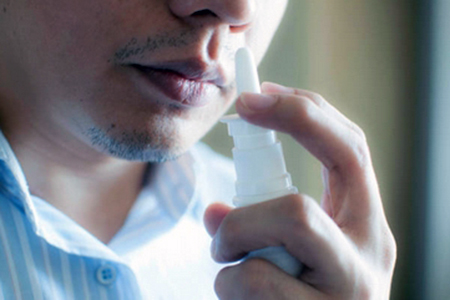Vasomotor nonallergic rhinitis – what is it and how is it treated and prevented?


Under the influence of unfavorable internal and external factors, blood vessels of the nasal cavity tend to become hyperactive and expanded. It results in the chronic inflammation called vasomotor rhinitis also called nonallergic rhinitis, meaning that it is not related to an allergic reaction.
Nonallergic rhinitis doesn’t include rhinitis caused by professional factors, intolerance to salicylates, an atrophic variant of pathology, and cases of the disease not associated with allergies, but accompanied by the appearance of immunocompetent cells in the nasal mucus (eosinophils, mast cells, neutrophilic leukocytes).
Short information about vasomotor nonallergic rhinitis
Stuffy and runny nose, alternated stuffy nose, nasal discharges going down the throat, impaired sense of smell.
Rare but possible: frequent sneezing, itching in the nose
Vasomotor rhinitis occurs in almost 10% of the population. A quarter of these patients suffer from persistent symptoms of the disease, and in half of the patients, the signs of pathology are moderately and significantly expressed. Women get sick 2 times more often than men and the average age of patients is 40 years. Worth noting, allergic rhinitis occurs 3 times more often than vasomotor rhinitis.
Very often, the disease occurs as a result of long-term use of decongestants, i.e. nasal sprays or drops to relieve a stuffy nose. Besides, it develops in every third pregnant woman.
Vasomotor rhinitis can develop at any age. It is important o timely diagnose and treat the disease to avoid complications.
Causes of vasomotor, nonallergic rhinitis
Vasomotor rhinitis mainly affects the inferior turbinates of the nose. They moisturize and warm the air, but in the presence of disease, this function is impaired, and the vessels of the mucous membrane react incorrectly to environmental conditions. It results in the occurrence of constant nasal congestion develops - the main symptom of vasomotor rhinitis. Violation of vascular regulation is associated with an imbalance of the autonomic nervous system, which is responsible for vascular tone.
External and internal factors cause such an imbalance. Environmental conditions include:

- Too low or high temperature;
- Fast change of atmospheric pressure;
- Air pollution by smoke, substances with a strong odor,
- The effects of spicy food, alcohol, nicotine and tar from cigarette smoke;
- The use of cocaine or other inhalable drugs;
- Respiratory diseases of a viral nature.
Internal factors that can provoke autonomic imbalance:
- Stress and strong emotions;
- Physical loads;
- Hormonal diseases: ovarian dysfunction (puberty, pregnancy, menstruation), hypothyroidism, excess growth hormone (acromegaly and gigantism);
- Pathological refluxes (throwing of contents) from the stomach into the esophagus, from the stomach into the pharynx, and from the pharynx into the larynx;
- Deformation (curvature) of the nasal septum;
- Decreased patency of the upper respiratory tract (adenoids in children).
There is a theory that an individual can have a hereditary predisposition to vasomotor rhinitis.

Medication-induced rhinitis can be of two types. First is related to the long-term use of vasoconstrictor drops or sprays, as a result of which vascular receptors lose sensitivity to internal vasoconstrictor factors and chronically expand.
The second type of medication-induced rhinitis occurs due to the prolonged use of drugs that affect the general tone of the autonomic nervous system. These are many drugs for hypertension (ACE inhibitors, alpha and beta-blockers, methyldopa, and calcium antagonists), antipsychotics, anticonvulsants, oral contraceptives, erectile dysfunction drugs (Sildenafil).
Quite often, rhinitis develops in pregnant women and disappears after childbirth. The reasons for this phenomenon are being studied by doctors. It is believed that hormonal imbalance, stress, an increase in the volume of blood circulating in the body are playing their roles in the onset of the disease.
Vasomotor, nonallergic rhinitis symptoms
- Impaired nasal breathing, constant or temporary, arising from one side, then from the opposite, especially when lying on the side and turning over;
- Moderate discharge from the nose;
- Discharge flowing down the back of the pharynx (in the upper throat).
In some patients, there is a clear connection between the onset of symptoms of pathology and eating, alcohol consumption, and being in the cold. In other patients, no obvious triggering factors can be detected.

Sneezing, itching, severe runny nose, and watery eyes are more common with an allergic-type of pathology. They can be observed with nonallergic rhinitis but much less often.
With medication-induced rhinitis, the main complaint is dependence on vasoconstrictor drops and sprays.
Examining the patient, the doctor may notice signs of an imbalance in the autonomic nervous system:
- Pallor or cyanosis (bluish color) of the skin and mucosa, cold extremities;
- Increased sweating;
- A tendency to a decrease in body temperature, blood pressure and a slowdown in the pulse;
- Drowsiness, irritability, hypochondriacal disorders.
Rhinoscopy shows that the inferior turbinates of the nose are enlarged, their surface is reddened, with a bluish tinge, or pale. Hemorrhages are sometimes visible.
Types of vasomotor, nonallergic rhinitis
The classification of nonallergic rhinitis is based on its causes and mechanisms of development. There are the following types of diseases:
- Medication-induced (caused by decongestants or oral medications);
- Hormonal (during pregnancy, puberty, endocrine system diseases);
- Reflexive (caused by food, cold and other triggers);
- Psychogenic (associated with emotional stress);
- Idiopathic (of an unexplained nature);
- Mixed.
Diagnostics of nonallergic rhinitis
The diagnosis of vasomotor rhinitis is made by exclusion of other possible causes of the symptoms. The only sign that makes it possible to speak with confidence about this disease is dependence on decongestants, i.e. nasal sprays or drops to relieve stuffy nose.

This pathology is defined as non-infectious non-allergic inflammation. Therefore, first of all, it is necessary to exclude chronic rhinosinusitis. This disease is usually caused by bacteria and is accompanied by mucous or purulent discharge in the mouths of the paranasal sinuses, headache, signs of intoxication, periods of exacerbation and remission. To exclude chronic rhinosinusitis, an X-ray examination or computed tomography of the paranasal sinuses is prescribed.
To exclude allergic rhinitis, skin tests with allergens (dust, pollen, animal hair, mold and others) or determination of antibodies to these allergens (specific IgE) in the blood are performed.
Other, less frequently used diagnosis methods include:
- Endonasal provocative test with methacholine (performed to exclude non-allergic rhinitis with eosinophilic syndrome);
- Electrophoretic analysis of nasal secretions;
- Rhinomanometry and acoustic rhinometry to assess the effectiveness of the treatment.
It should be borne in mind that allergic rhinitis is not always immediately accompanied by characteristic changes. In about a quarter of patients with initially negative allergy tests, they become positive after 3 years. This makes it necessary to reconsider the diagnosis and is often observed in pediatric practice.
Vasomotor rhinitis should not and cannot be a diagnosis made at the first visit to the ENT doctor. More research is needed as listed above. You may need to consult other specialists - an allergist, neurologist, endocrinologist, gynecologist, and/or gastroenterologist.
Treatment of nonallergic rhinitis
Treatment of vasomotor rhinitis in adults and children should be carried out taking into account the triggering factors of the disease, both external and internal, and their elimination.
Home therapy
If the symptoms are determined to be related to certain conditions (alcohol consumption, stress, etc.), lifestyle changes should be made to avoid these situations. It is important to influence the function of the autonomic nervous system through regular exercise and conditioning.
Folk remedies for nonallergic rhinitis
Popular folk recipes for vasomotor rhinitis:

- Nasal drops made of beet juice, Kalanchoe, birch sap, home aloe plant, menthol oil;
- Lubrication of the mucous membrane with ointments based on petroleum jelly and walnut or calendula leaves;
- Rinsing the nasal cavity with honey solution;
- Acupressure in the area of the bridge of the nose and at the upper edge of the wings of the nose;
- Breathing exercises, including a slow inhalation through one nostril, and an even slower exhalation through the other; exercise must be repeated 10 times for each nostril every day for at least a month.
Drug therapy of nonallergic rhinitis
Several groups of drugs are used to treat vasomotor, nonallergic rhinitis in adults:

- Topical and systemic (in pills) blockers of H1-receptors (azelastine, levocabastine, Cyproheptadine) for nasal discharge, sneezing, congestion;
- Intranasal glucocorticoid drugs with a predominance of congestion among he symptoms;
- Local stabilizers of mast cell membranes with a predominance of sneezing and congestion in children over 2 years old;
- Local M-anticholinergics (ipratropium bromide) with the prevalence of strong nasal discharge;
- Blockers of peptidergic neurons (capsaicin);
- Botulinum toxin A.
The drugs of the first choice are glucocorticoids for intranasal use - Avamis or Flixonase (Fluticasone) and Beclomethasone sprays, Nasonex (Mometasone), and other sprays.
For the treatment of vasomotor rhinitis in children over 6 years of age, Budesonide nasal spray is used as follows: 1 - 2 doses, 1 - 2 times a day for 3 months. The exact dosage should be chosen by the doctor in accordance with the age of the child. It is recommended that you rinse your nose or your child’s nose with saline solution before using the hormonal spray.
Budesonide is also recommended for the treatment of drug-induced rhinitis, the course of treatment is at least 2 months. If ineffective, short-term use of Prednisolone tablets is possible. If these measures do not help the patient to quit using decongestants, surgery is the only option.
Treatment of nonallergic rhinitis in pregnant women

First of all, a woman should exclude the exposure to triggering factors such as passive smoking, manage gastroesophageal reflux disease (GERD), avoid being in cold, etc.
The most effective and safe method of therapy in this group of patients is nasal lavage with saline, seawater irrigation, breathing exercises and occasional use of decongestants (vasoconstrictor nasal sprays).
The most studied and relatively safe glucocorticoid that can be used in pregnant women is Budesonide. It is prescribed for already existing allergic rhinitis, complicated by the joined vasomotor type of the pathology.
Surgical treatment of nonallergic rhinitis
At the beginning of treatment, the only surgical manipulation that should be performed in patients with vasomotor rhinitis is the correction of a possible deformity/curvature of the nasal septum. Other surgical interventions should be considered only if after a year of drug therapy there is no improvement of the condition.

Any operation for vasomotor rhinitis only makes nasal breathing easier. It has very little effect on symptoms such as nasal discharge, itching, sneezing, and deterioration of smell.
With vasomotor rhinitis, the following interventions can be performed:
- Displacement of the turbinate;
- Removal of part of the bone and soft tissue under the mucous membrane;
- Plastic surgery techniques;
- Superficial or submucosal interventions.
It is preferable to use the last group of operations: vasotomy, electrocoagulation, ultrasonic disintegration, laser intervention, shaver or radiofrequency reduction, cryosurgical method. The choice of the method of intervention is determined individually for each patient. The intervention can be supplemented by partial denervation of the vessels of the mucous membrane.
Surgical treatment of vasomotor rhinitis is also carried out in children. It is often combined with the removal of the adenoids, the correction of the nasal septum, and other interventions.
The result of any surgery for vasomotor rhinitis may be unstable. Re-intervention is sometimes required.
Possible complications of nonallergic rhinitis
With a prolonged course, vasomotor rhinitis may be accompanied by complications:
- Persistent nasal congestion, causing sleep disturbance and impairing the ability to work, study, and perform any activities;
- Persistent deterioration of the sense of smell;
- Development of chronic rhinosinusitis, frequent colds;
- Formation of polyps or mucosal atrophy.
Prevention of nonallergic rhinitis
Given the possible provoking factors of the disease, the following actions are required for its prevention:
- Avoid prolonged stay in rooms with polluted air, if necessary, use respirators;
- Get flu vaccine; try not to get sick during the cold season;
- Correct hormonal disorders in time;
- Treat gastroesophageal reflux disease and other pathological refluxes;
- When the first symptoms of ENT pathology appear, immediately consult an otorhinolaryngologist.
If you need drugs to treat vasomotor nonallergic rhinitis, for instance, Periactin (Cyproheptadine) or Budesonide you can order them from our online drugstore without a prescription but make sure to consult your doctor first and undergo all necessary tests.
Post by: Emma Ager, MD, Copenhagen, Denmark
(Updated at Apr 14 / 2024)
Periactin articles:
Some of the trademarks used in this Web Site appear for identification purposes only.
All orders are reviewed by a licensed physician and pharmacist before being dispensed and shipped.
The statements contained herein are not intended to diagnose, treat, cure or prevent disease. The statements are for informational purposes only and is it not meant to replace the services or recommendations of a physician or qualified health care practitioner. If you have questions about the drugs you are taking, check with your doctor, nurse, or pharmacist.